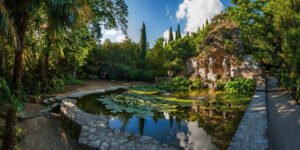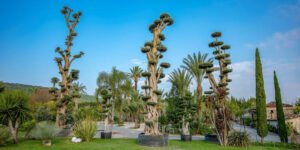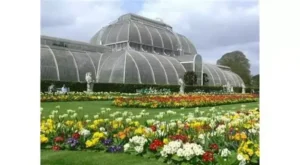Description
Exploring Nature’s Hidden Gem: İzmir Botanic Garden, Turkey
Nestled in the heart of the Aegean city of İzmir, the İzmir Botanic Garden (İzmir Botanik Bahçesi) offers a refreshing escape from urban hustle, a sanctuary where nature thrives in curated beauty and wild freedom. This verdant retreat not only showcases Turkey’s rich botanical diversity but also reflects İzmir’s deep-rooted relationship with flora, science, and education. Whether you're a plant enthusiast, a casual traveler, or a family looking for a peaceful day out, the İzmir Botanic Garden is a destination you won’t want to miss.
A Green Jewel in the City
Located within the campus of Ege University in the Bornova district, the İzmir Botanic Garden is often overlooked by mainstream tourist guides, yet it holds one of the richest and most scientifically curated plant collections in Turkey. Spread across over 40 hectares, the garden is both a research facility and a leisure space, serving students, scientists, and nature lovers alike.
Established in 1961, the garden was originally designed to support academic research for Ege University's Faculty of Science. However, its role has since expanded, and today, it serves as a public space where people can learn about plant conservation, ecological sustainability, and the stunning biodiversity of Anatolia and beyond.
Botanical Diversity at its Best
The İzmir Botanic Garden boasts a collection of more than 3,000 plant species, including native, endemic, and exotic varieties from all over the world. From Mediterranean shrubs and Anatolian wildflowers to cacti, succulents, and tropical palms, the diversity is both astonishing and educational.
The garden is divided into several thematic sections:
-
Systematic Garden: This section is organized according to plant taxonomy. Visitors can observe the evolutionary relationships between plant families and species, a fascinating insight for botany enthusiasts.
-
Rock Garden: Featuring alpine plants and native rock-dwellers, this area simulates the rugged landscapes of high-altitude regions and showcases how flora adapt to extreme conditions.
-
Greenhouses: Tropical and subtropical plants thrive here in carefully controlled climates. Giant ferns, orchids, bromeliads, and even carnivorous plants can be found in these lush indoor environments.
-
Medicinal and Aromatic Plants Section: Turkey has a long tradition of herbal medicine, and this section pays homage to that heritage. Here, visitors learn about plants used in traditional Anatolian remedies and modern pharmaceuticals alike.
-
Endemic Plants Area: This part of the garden highlights Turkey’s unique plant life, many of which can’t be found anywhere else on Earth. Protecting these species is a key mission of the garden’s conservation program.
A Living Classroom
As part of Ege University, the İzmir Botanic Garden plays a critical educational role. It serves as an open-air classroom for biology, ecology, and pharmacy students, offering hands-on experience in plant cultivation, taxonomy, and conservation.
Workshops, seminars, and guided tours are organized regularly, often aimed at children and school groups. These programs aim to foster environmental awareness and inspire future generations to respect and protect the natural world.
Eco-Tourism and Sustainability
The garden is a great example of eco-tourism in action. By promoting biodiversity and sustainable land use, it aligns with Turkey's broader goals of environmental education and preservation. Visitors are encouraged to engage respectfully with the space—no picking flowers, no littering, and no disturbing wildlife.
Moreover, the garden’s irrigation systems and waste management practices are designed to minimize environmental impact, making it a model for sustainable landscape design.
Seasonal Highlights
Each season brings a new wave of color and life to the garden:
-
Spring (March–May): This is the most vibrant time, as thousands of tulips, irises, and poppies burst into bloom.
-
Summer (June–August): Tropical plants in the greenhouses thrive, and the cacti and succulents dazzle in the sun.
-
Autumn (September–November): The foliage of deciduous trees paints the garden in warm hues of red, orange, and gold.
-
Winter (December–February): While quieter, winter has its charm too, especially in the greenhouses and among hardy evergreens.
Visitor Information
Getting There: The garden is easily accessible via İzmir’s public transport system. You can take the metro to Ege Üniversitesi station and walk a short distance to the entrance. Taxis and ride-sharing services are also available throughout the city.
Opening Hours: Typically open from 9:00 AM to 5:00 PM, Monday through Saturday. It's always a good idea to check in advance, especially on public holidays.
Entry Fee: As of the latest updates, entrance is free, making it an accessible option for all visitors.
Amenities: Benches, shaded picnic areas, restrooms, and educational signs are available throughout. However, there is no on-site café, so bringing your own snacks and water is recommended.
Accessibility: The main paths are suitable for wheelchairs and strollers, although some rockier or wooded areas may be challenging for those with limited mobility.
Why You Should Visit
In a city famous for its coastline, archaeological sites, and lively bazaars, the İzmir Botanic Garden offers something different—a chance to slow down, breathe deeply, and connect with the natural world. It’s a place where science and serenity coexist, and where visitors can learn not only about plants but also about the ecosystems and cultures that sustain them.
Whether you're a local looking for a peaceful walk, a student curious about plant biology, or a traveler seeking an off-the-beaten-path experience, the İzmir Botanic Garden is a rewarding and enriching destination.
Location
-
Kazımdirik, Mustafa Kemal Cd. No:47, 35100 Bornova/İzmir



